Nikon DX AF-S Nikkor 35mm 1: 1.8G SWM Aspherical (abbreviated as Nikon 35mm f / 1.8G DX) was announced on February 9, 2009. Now this lens is quite popular and it is easy to find both new and used.
In brief about the Nikon DX AF-S Nikkor 35mm 1: 1.8G SWM Aspherical
Nikon 35mm f / 1.8G DX IS standard fast fixed lens for Nikon DX cameras... In this case, the word 'standard' refers to the focal length and means that the lens provides a moderate angle of view of 44 ° across the frame.
Nikon 35mm f / 1.8G DX has large aperture... The maximum relative aperture to which the lens aperture opens is 1: 1.8, which is a very good indicator. The Nikon 35mm f / 1.8G DX is usually a complement to 'dark' versatile zoom lenses such as Nikon 18-55mm 1: 3.5-5.6GII VR II AF-S DX Nikkor or Nikon 18-105mm 1: 3.5-5.6G ED Nikkor VR AF-S SWM DX IF Aspherical. If we compare the maximum aperture of F / 5.6 used in these zoom lenses with the F / 1.8 used in the Nikon 35mm f / 1.8G DX, the difference will be more than 2 steps, which is about 10 times. Thus max aperture this lens is 10 times larger than regular zoom lenses mounted at the extreme zoom position. So big aperture simplify shooting in low-light conditions. For example, in due time I shot without problems on this lens in temples wedding ceremoniesand baby baptism.
Nikon 35mm f / 1.8G DX is a fixed lens, which means its focal length is always the same (there is no zoom function). Fix lenses make it much easier and at a more modest price to get very good optical performance. So, this Nikon 35mm f / 1.8G DX has very good sharpness, inaccessible to a large number of zoom lenses.
The Nikon 35mm f / 1.8G DX is also a very compact and lightweight lens, it is easy and simple to always carry. Below you can see photos from my vacation, for which I took a lightweight Nikon 35mm f / 1.8G DX along with a lightweight camera Nikon D40.
To summarize quickly, the Nikon 35mm f / 1.8G DX is a lens from the category 'Must Have'. 35 mm focal length on the camera Nikon DX give the same angle of view as a 52.5mm lens (virtually the same 'half a ruble') on the camera Nikon fx. Such a lens is suitable for a wide range of photo tasks.
Main technical characteristics of Nikon DX AF-S Nikkor 35mm 1: 1.8G SWM Aspherical:
| Review Instance Name | Nikon DX AF-S Nikkor 35mm 1: 1.8G SWM Aspherical 2166388 |
| Basic properties |
|
| Front Filter Diameter | 52 mm, plastic thread for filters |
| Focal length | 35mm Equivalent Focal Length (EGF) for cameras Nikon DX is 52,5 mm (Spoiler: I’ll soon get away from these meaningless comments about focal lengths and their recounting. Everything is exactly as described above. Without options.) |
| Zoom ratio | 1 X (this is a fixed lens, it does not have a zoom) |
| Designed by | for Nikon DX digital cameras (with APS-C sensor) |
| Number of aperture blades | 7 rounded pieces |
| Tags | bayonet mount tag and hood mount |
| Diaphragm | F / 1.8 to F / 22, without aperture ring. |
| MDF | 0.3 m, the maximum magnification ratio is 1: 6.3 (the smaller the second number, the better the ability to macro) |
| The weight | 200 g |
| Optical design | 8 elements in 6 groups, 1 aspherical element (in the optical diagram, the aspherical element is shown in blue). The presence of such elements on the lens barrel is indicated by the inscription 'Aspherical'. The image of the optical circuit is clickable.
Most likely the aspherical element is a hybrid aspherical, i.e. consisting of a conventional spherical lens coated with plastic aspherics. |
| Lens hood | Nikon HB-46 |
| Manufacturer country | MADE IN CHINA (Made in China) |
| Period | From March 2009 to the present |
| Instructions | View -> |
| 3d view | View -> |
| Price |
It just so happens that the Nikon 35mm f / 1.8G DX is the only truly 'fast' prime lens specifically designed for cameras Nikon DX. Other fixed lenses Nikon
- Nikon DX AF Fisheye Nikkor 10.5mm 1:2.8G ed
- Nikon DX AF-S Micro Nikkor 40mm 1:2.8G SWM.
- Nikon DX AF-S Micro Nikkor 85mm 1:3.5G ED VR SWM IF Micro
have much less aperture.
Assembly
The copy from this review was made in China. The Nikon 35mm f / 1.8G DX is quite pleasant to the touch, its plastic body does not cause any discomfort. It is very good that the lens uses a metal mount, which is at least some sign of a quality lens assembly. The lens uses commonly used 52 mm filters.
Please note that the Nikon 35mm f / 1.8G DX mount side has a special dustproof and waterproof mount seal, which is an indication that the lens has a base mount. dust and moisture protection. Unfortunately, the rest of the case is not protected from the negative impact of the external environment. More information on the all-weather protection of Nikon SLR lenses can be found here.
Nikon 35mm f / 1.8G DX uses a rubberized focus ring. There are bayonet mount tags and a tag for quick hood installation on the case. The lens uses a strong plastic lens hood HB-46, which is fixed in special grooves located near the front lens of the lens. The lens hood comes with the lens. The hood can be installed in the opposite direction for transportation. In this position, access to the focus ring is completely lost.
The Nikon 35mm f / 1.8G DX comes with a soft velor case CL-0913, with which you can transport the lens.
Focusing
Nikon 35mm f / 1.8G DX focuses quietly thanks to 'SWM'-motor (Silent Wbird Motor - quiet wave motor) and refers to the lens'AF S'type (with built-in motor focusing), and therefore it will automatically focus on any Nikon digital SLR camera.
Auto Focus Speed - average. I want to note that the Nikon 35mm f / 1.8G DX focuses slower than Nikon AF-S Nikkor 50mm 1: 1.8G SWM Aspherical и Nikon 50mm 1: 1.8D AF Nikkor. On cameras Nikon D40 и Fujifilm FinePix S5 Pro the lens focuses tenaciously and does not release objects from the field of focus. Note that there are a lot of rumors on the net that the lens may not focus accurately (have 'back' or 'front' focus). I've had 4 different similar lenses in use all the time, and they all worked and focused properly.
During focusing, the front lens remains stationary. The lens uses RF focusing (Rear Focusing), which is done by moving the back of the lens group. For practical use, focusing type RF is no different from focusing type IF ('Iinternal Focus' - 'Inner Focus'). With this lens, you can easily use any filters, for example, polarizing.
The minimum focusing distance is only 30 cm, while you can shoot Macro with 1: 6.3 magnification... The Nikon 35mm f / 1.8G DX has neither a window with a distance scale, nor a depth of field scale, nor a mark for working in the infrared spectrum. In manual focusing mode, the ring rotates approximately 90 degrees, when reaching the extreme positions, it does not rest against it, but continues to slide without affecting focusing. Manual aiming is easy. True, some users of this lens still blame the tight rotation of the focusing ring.
On the lens housing you can find focus switch 'M / A - M'. In the 'M / A' position, auto focus works with constant manual focus priority. The 'M / A' mode is very convenient and useful - for manual focusing or focus correction, you do not need to additionally switch the lens to the 'M' mode. You can turn on the 'M / A' mode and forget about this switch forever.
Diaphragm
Diaphragm lens consists of 7 rounded petalswhich form a fairly even hole. Diaphragm closes to F / 22. The lens does not have an aperture control ring, nor does the DOF scale.
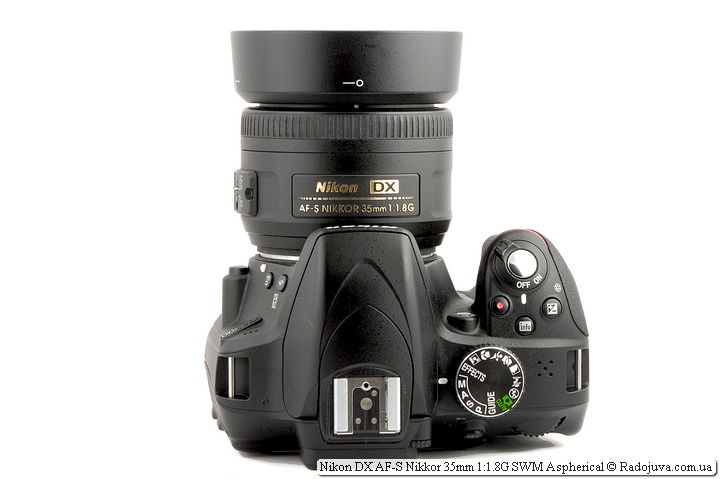
Nikon DX AF-S Nikkor 35mm 1: 1.8G SWM Aspherical with Nikon HB-46 lens hood Nikon D3300
Lens features on Nikon FX full-length cameras
Interesting: the lens has a good margin of performance, it can work with grief in half and on full-size Nikon FX cameras (for which it is not designed to work) Here is the link on mine sample photos on Nikkor AF-S 35mm f / 1.8G DX and full-format camera in FX image area mode.
Image quality
Good picture quality is obtained due to use aspherical element in the optical circuit of the lens. On foreign sites they write that the lens uses plastic inserts for a hybrid aspherical element, I did not find detailed information about this. Chromatic aberrations (HA) are highly visible until F / 3.2. The purple halo (Purple fringing), which is difficult to remove even when shooting in RAW and post-processing. To catch such a halo, you need to try. The purple halo border is the only major drawback of this lens.
In general, the lens has “cream” bokeh. Don't expect the lens at f / 1.8 to blur the background too much when photographing portraits. For portraits, any half a ruble (50mm fixed lens). I recommend reading my article about how to take pictures with a blurred background.
Distortion 35 mm still remained and quite a bit makes its own negative adjustments.
Vinienting imperceptibly at any aperture. Natural color renderingeasily fixed by setting white balance in the camera. Lens very sharp at any aperture.
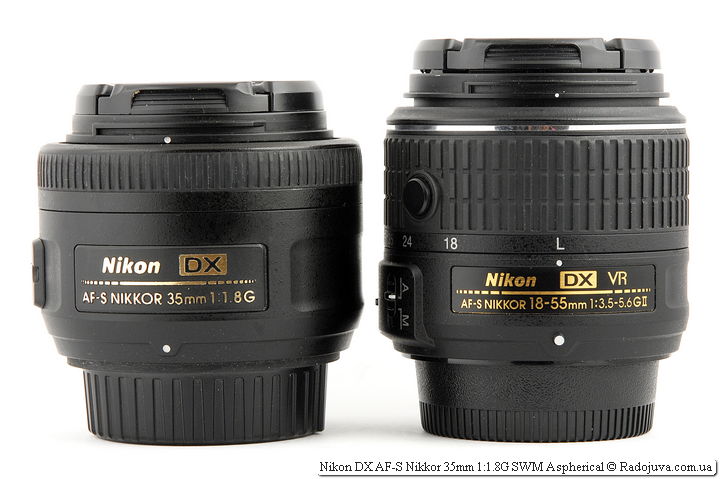
Dimensions Nikon DX AF-S Nikkor 35mm 1: 1.8G SWM Aspherical and Whale Lens Nikon 18-55mm 1: 3.5-5.6GII VR II AF-S DX Nikkor
Alternatives
If you are looking for a lens of this class, then The following lenses can serve as alternatives at a similar cost or functionality:
- Sigma 30mm F1.4 DC HSM ART
- Sigma 30mm 1: 1.4 EX DC HSM
- Nikon DX AF-S Micro Nikkor 40mm 1: 2.8G SWM
- Yongnuo 35mm 1: 2 (YN35mm F2N, for Nikon cameras)
My experience:
The 35 mm fix, even on the DX matrix, is quite short and not familiar to me, but shooting with this lens is a fairy tale! Ergonomics and functionality on top. All those who want to upgrade their whale lens, I recommend this particular Nikkor AF-S 35mm f / 1.8G DX.
More examples of photos on the Nikon DX AF-S Nikkor 35mm 1: 1.8G SWM Aspherical with source RAW files can be found in the review Nikon D3300.
Lens prices
The real prices for Nikon DX AF-S Nikkor 35mm 1: 1.8G SWM Aspherical can be found in stores and catalogs:
Comments on this post do not require registration. Anyone can leave a comment. Many different photographic equipment can be found on AliExpress.
It is often difficult to choose between Nikon DX AF-S Nikkor 35mm 1: 1.8G SWM Aspherical and Nikon AF-S Nikkor 50mm 1: 1.8G SWM Aspherical, thoughts about this find here.
I am also often asked how this lens differs from Nikon AF Nikkor 35mm 1: 2D, the difference is described in detail here.
An accurate list of all Nikon DX Nikkor lenses
- 10.5 mm/ 2.8G AF Fisheye [gold ring]
- 35 mm/1.8G AF-S
- 40 mm/2.8G AF-S Microphone
- 85 mm/3.5G AF-S VR Microphone
- 10-20 mm/4.5-5.6G AF-P VR
- 10-24 mm/3.5-4.5G AF-S
- 12-24 mm/4G AF-S [gold ring]
- 16-80 mm/ 2.8-4IN AF S VR [gold ring]
- 16-85 mm/3.5-5.6G AF-S VR
- 17-55 mm/2.8G AF-S [gold ring]
- 18-55 mm/3.5-5.6G AF-S [black / silver]
- 18-55 mm/3.5-5.6GII AF-S [black / silver]
- 18-55 mm/3.5-5.6G AF-S VR
- 18-55 mm/3.5-5.6GII AF-S VR
- 18-55 mm/3.5-5.6G AF-P
- 18-55 mm/3.5-5.6G AF-P VR
- 18-70 mm/3.5-4.5G AF-S
- 18-105 mm/3.5-5.6G AF-S VR [Thailand / China]
- 18-135 mm/3.5-5.6G AF-S
- 18-140 mm/3.5-5.6G AF-S VR [Thailand / China]
- 18-200 mm/3.5-5.6G AF-S VR [Japan / China]
- 18-200 mm/3.5-5.6GII AF-S VR
- 18-300 mm/3.5-5.6G VR
- 18-300 mm/3.5-6.3G VR
- 55-200 mm/4-5.6G AF-S [black / silver, Japan / China]
- 55-200 mm/4-5.6G AF-S VR
- 55-200 mm/4-5.6GII ED VR
- 55-300 mm/4.5-5.6G AF-S VR
- 70-300 mm/4.5-6.3G AF-P
- 70-300 mm/4.5-6.3G AF-P VR
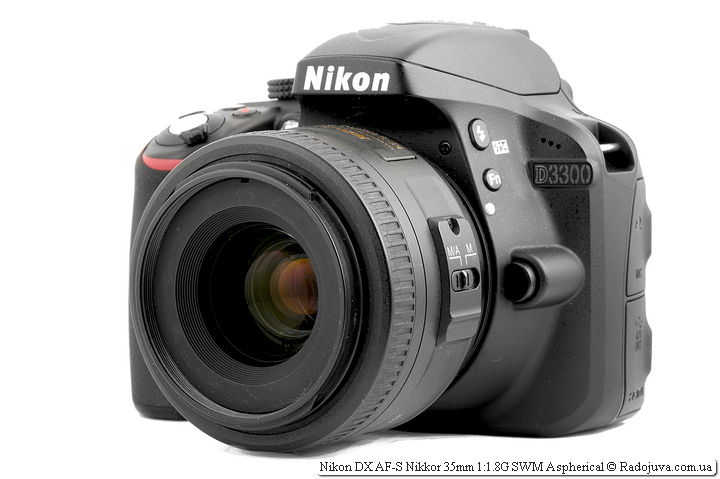
Nikon DX AF-S Nikkor 35mm 1: 1.8G SWM Aspherical on Camera Nikon D3300
Results
Nikon DX AF-S Nikkor 35mm 1: 1.8G SWM Aspherical is an excellent standard high-aperture prime lens for cropped Nikon DX cameras. The lens has excellent sharpness and compactness, works on all digital SLRs Nikon. The lens has only one serious drawback - strong purple halos on the contrasting details of the image.
If you have any question about this lens, feel free to ask it in the comments and they’ll answer for sure. Also, in comments write your reviews, impressions, opinions and ratings of this lens.
UPDATE 1: A cheap similar lens went on sale in 2016 - Yongnuo 35mm 1: 2 (YN35mm F2N, for Nikon cameras, review at this link).
UPDATE 2: in 2020, a large overview of the premium lens appeared on Radozhiv Sigma 30mm 1: 1.4 DC A (Art).
Material prepared Arkady Shapoval. Training/Consultations | Youtube | Facebook | Instagram | Twitter | Telegram

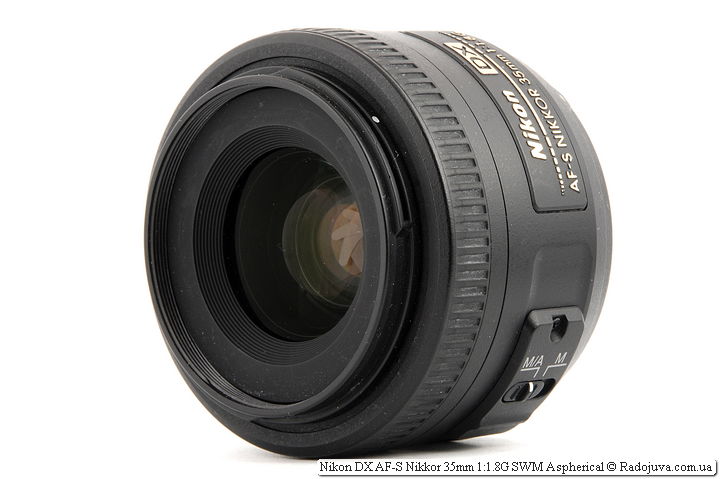




















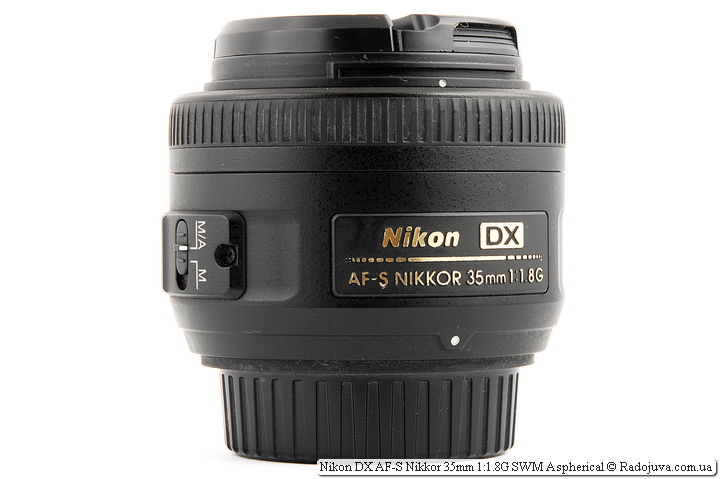
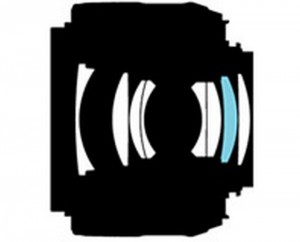
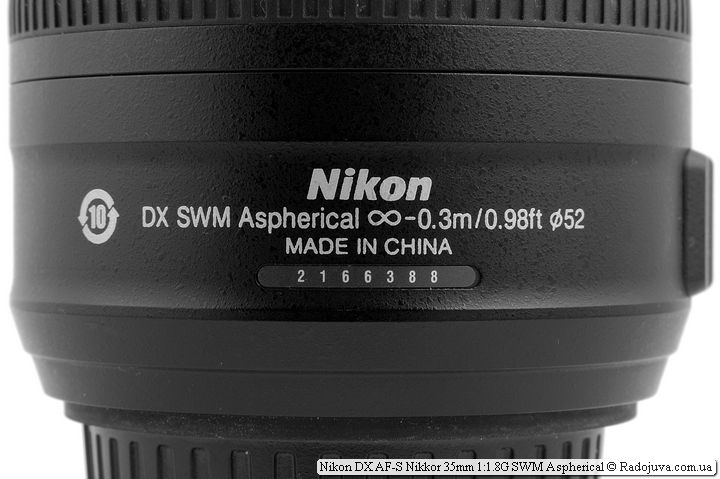
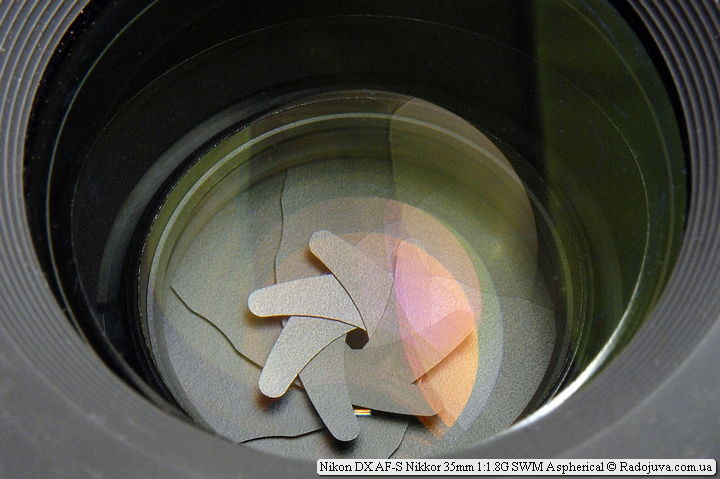















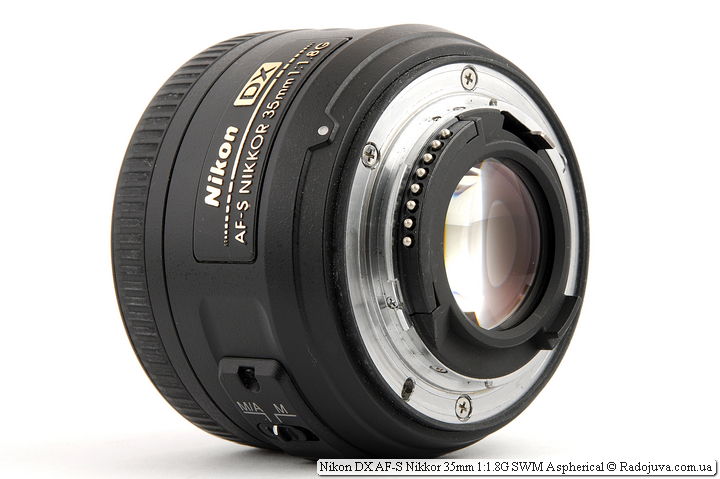
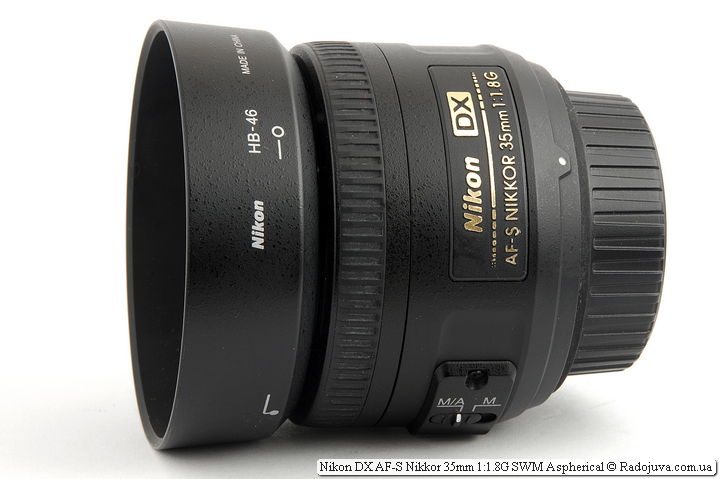
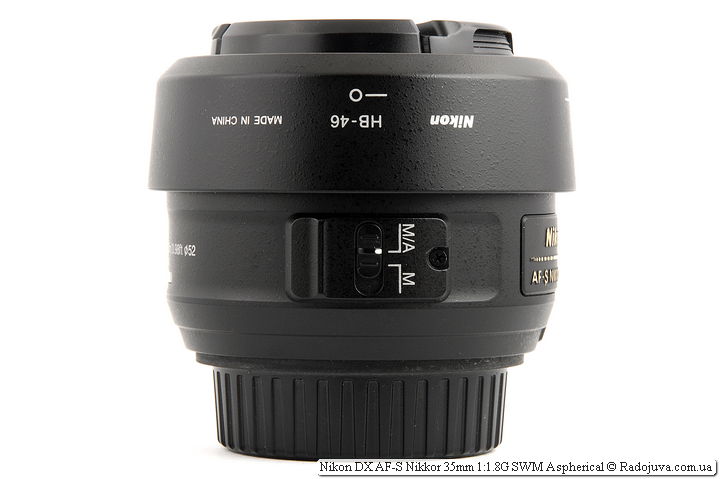































I have been using this lens for 2.5 years, razor sharpness ... even at 1.8, who doubts about the first fix, do not even think, buy and shoot with joy!
God shamelessly lens. It stops showing purple halos if you clamp the diaphragm to 4 or more.
And ???
And only for pampering suits 1.8 is not working. It is better to take sigma 17-50 2,8.
You are out of luck, your instance is not successful, or you are doing something wrong. Mine at 1,8 well, just very good. And by the way, I found this only by removing the marumi protective filter.
Hello. Do you think that a simple protective filter degrades the picture? I acquired such a fix and was going to install a c / filter, do not advise, there are very few places, as I looked, is the lid closed normally?
Yes, it worsens. Protective filter, only for protection, dirt, shock, etc. If none of this exists, then protection is not needed.
Sorry for the tautology.
Thank you.
Bright, it's because marumi. I think this brand is the lower threshold of what you can take. Then just the bottom. With filters of normal manufacturers in 95% of cases there is no difference (evening shooting does not count).
Specific example. Shooting with ND8 marumi is soap, with nd64 / nd1000 hoya pro1 - sharply.
though I do not exclude that there are many fakes for marumi on the market and in fact they are good ...
Hello! Sorry for the newbie question. I have a Nikon D5100 with a Nikkor 18-55 1: 3.5-5.5 GII lens. I would like to take pictures of my family indoors without using a flash, but with a standard lens I can't do very well - everything is blue, then dark, then overexposed and blurred. Changing the aperture, shutter speed, ISO - did not help much (you can photoshop, but you want a "live" color). Can you please tell me: are my hands growing lower than necessary or is this lens not suitable for my desires? If the lens, then could you tell me what parameters the lens should have in order to fulfill my desires, i.e. taking pictures indoors (standard apartment) without flash and getting decent shots?
Thanks in advance for any advice and of course criticism !!!
for photography in an apartment, the lens from this review is better than the whale you are shooting with now (except for the lack of a wide angle). For a better understanding of why “everything is blue, then dark, then overexposed and blurred,” read articles on this site about white balance, camera metering modes and how to photograph handheld. Indoors, without flash, it is good to photograph in daylight from a window. And if you shoot under artificial lighting in combination with light from a window or several artificial sources with different color temperatures (incandescent lamp + energy-saving lamp + LED), then the camera's auto BB will not cope with this task normally - the color will be hellish.
Thank you very much!
I love this lens, on my d40 I only go with it.
> Interesting: the lens has a decent performance headroom
What is meant by lens performance?
Shows excellently in sharpness on 24 megapixel cameras, and this is the very stock.
Camera 3200 and 300s. Enjoyed 18-105. Bought 35 G. Only positive emotions. There are subtleties. It focuses on non-contrasting objects in 2-3 attempts, but I think it's okay. And here is the picture day and night !!! 1.8 performed well in the basement. Small compensation +0.7 and great photos. The lighting was complicated, brick walls, wooden beams - I didn't bother, but just set the balance on a white napkin and the result was good !!!! For that kind of money +++! Of course I thought about 24 G. I like to shoot the city. I looked closely at my family 10-24. Maybe Arkady will advise that. There are of course tokens. Eh, to test it. Good lighting to everyone !!!!
Good day to all!
About Nikon DX AF-S Nikkor 35mm 1: 1.8G, so much has been said here that too much will say about it, both good and bad. I want to offer my own, but is it good or bad to judge you. I'll start from afar. My first Nikon is D3000 with 18-55 and 55-200 mm, then I bought 18-200. Later I bought D7100 and 18-300. I photograph for myself and after reading about 35 mm, I decided to buy it. I bought it two months ago, as an amateur is satisfied with everything, but as mentioned above, there is not enough wide angle for the room. So I bought myself a nozzle (lenses). Consists of two lenses. For the price, quite inexpensive, but the wide angle gives, not even very bad. This is the so called 0.45x Wide Angle with “MACRO”. It is screwed onto both the lens itself and the light filter, 52 mm thread. Front thread 62 mm.
Photo #2
Photo #3
Here's how it looks on the Nikon D7100
Photo #1
On the D7100
MACRO did not try the lens itself, all hands do not reach for photographing. But the assembly really liked it. I enclose a photo. Taken from the hand, from one place. One photo without a nozzle, the second with a nozzle.
Photo without lens attachment.
Photo with a lens attachment.
The difference in wide angle I think is noticeable.
Taken from one place.
Greetings
My head boiled, please forgive me for asking!
If we compare 35 / 1,8 with the whale 18-55, throwing off the “holes” parameter, how different are the images (angle of view), sharpness, color rendering?
Carcass D5300. The pictures are rather not artistic, at work, dynamic (both hands and the target)
Thank you
The viewing angle of 35 1.8 is the same as that of 18-55 in the 35mm position.
The sharpness of the fix is almost always higher, there is no exception. Moreover, 35 1.8 is sharper even on more open holes, which is very noticeable. Plus, angles are noticeably better on similar diaphragms.
Color rendering for me is more dependent on the carcass and on the processing than on glass. There are lenses that bring their own colors to the camera, but 35 1.8 and 18-55 are not one of them. Both display colors roughly the same, but not bad at all.
Well, flipping the hole parameter is essentially forgetting the main plus of a 35mm lens - aperture. As for me, if it had a 3.5 aperture, it would hardly be bought. All the beauty is in the hole :)
Thank you!
PS.
I would be grateful if you send in the right direction.
There is a need to add corrective diopter to the video finder. I have (-2,5-3)
Google red ..)
Thank you
I have not tried it myself, but there is such a device link
Yuri, thanks! I probably didn’t ask correctly.
Interest closer to the DK-20C
And within Ukrainian shops
Hello, I would like to inquire about how half-length portraits are obtained with this (35mm) lens (camera d5300) (because mostly full-length portraits are advised, but I would like something closer to something - at least a half-length portrait), I just heard that with larger portraits, distortions are obtained on the faces, and I would like to know if there are significant distortions, or those that can, in principle, be corrected in Lightroom?
As for me, there are no noticeable distortions on the faces - it's still not super-wide. In addition, there are thousands of portraits on the Internet, including half-length portraits, shot by pros on ff and 50mm, but here, in essence, the situation is the same. I can't say that the 35 1.8 is ideal for portraits, but it suits these purposes quite well. Unless you can already notice distortions on the facial ones, and even then for some people they are on the contrary to the face - it depends on the specific person.
Thank you, in general, waist-length, not too large, the portrait can be shot relatively reliably with this lens))) I think the growth portrait will not cause problems! It’s just that this lens is relatively affordable compared to others, although if not for the current course, it would be generally wonderful !!! Well, I’d rather quickly try something new and get rid of the whale (18-55). Yes, at 500 pixels I saw good pictures taken on this lens!
Max, buy 85 1,8G for portraits, it costs more, but portraits will be better, when you switch to full frame, the glass will remain. Portraits will be able to shoot any, on the crop, even facial, easily. You need to learn how to shoot portraits at 35 mm, and at 85 any schoolchild can type, like me: https://500px.com/photo/168093883/backstage-by-yuriy-segeda
Thank you for the advice, but the fact is that the price will already noticeably bite beyond 85mm, with the current rate even 35ka beats on the budget, and the desire to get rid of the whale (18-55) is great, I want to try something new! Well, after reading all sorts of sources, I got the impression that for a start, 35mm is a very good lens also for its price, supposedly it will even be quite universal for different tasks, of course, this versatility is relative, otherwise why then other lenses, the same 85mm , which is usually called a portraitist! In general, in thought ...
Why get rid of a whale? 35mm will not replace it. and given the fact that KIT lathers at the focal length with approximately 44mm, it might be better to take 50mm?
Well, if you choose between 35 and 50, then 35 is said to be more universal on crop matrix. Of course, opinions can be different in people, but the fact that 35 is more universal than 50 I often came across with such statements. Well, many wrote that after buying a fix, whether it's 35 or 50, and so on, they no longer used the KIT.
I took a photo to the beach from 18-55 (for 18-105 is large and noticeable), most of the frames are at 55mm, there are at 30mm. I take 18-55 for a visit, plus a flash in the ceiling, FR 18 - 40mm. The meaning is convenient and not a pity, in such reports the main thing is interesting moments, angles, and not bokeh, volume, etc. At home I prefer 35 / 1,8 g, in the yard - 50 / 1,8 d or 55-200 Vr. I don't know what to advise you.
The fact that 35 is more universal on a crop than 50 is true, but you are mistaken about a whale. Having several fixes, including 35 and 50 and 105 and 200, I very often and with pleasure use 18-55 for a variety of tasks from macro to landscape.
they’re just so cool that they can shoot anything with a fix)
After buying 35 and 50, I used the whale. And even after 85 and 135 he used it. And I use zooms 24-70 2.8 and 70-200 2.8 :) Don't sell a whale, a whale is a thing! :) Small, convenient, never mind.
whale is better not to sell yet
Yeah, I also think that it’s still useful later)))
ok get.
Hello. Tell me, please, how to focus on infinity with this lens and Nikon D80 camera? So that everything in the frame is as sharp as possible? For example, when shooting the same landscapes.
The lens does not have a corresponding designation scale.
It is enough to turn the focusing ring to the extreme position until it starts to slide (tactilely easy to feel). The direction can be determined by the JVI. Unfortunately, the lens does not have a hard stop, and therefore infinity with the focusing ring turned all the way is not quite “infinity”.
Understood thanks!
Andrey, as an option, you can focus on the object located on the border (closer to you) of the frame, therefore, holding the shutter button half-pressed, recompose the frame and click. Of course, you also need to cover the diaphragm.
Hello a week ago I bought a Nikon AF-S 35mm f / 1.8 G DX Nikkor lens on the D3300. Pictures are soapy. 1 out of 20 is sharp. What is this happening for? RAW files with a whale 18-55 lens and 35. The settings are the same F4.5, 1/160, 35mm. The whale shot is sharper. This I chose the sharpest photo on the 35 lens. On the whale, everyone is the same. Maybe you need to do the adjustment? Help me please. Files by link https://cloud.mail.ru/public/AYLE/xGq7DxxfD
Try shooting in Live View.
Thanks. I'll try in the evening
Nafotkal. https://cloud.mail.ru/public/DhRz/eUYsLTNw3
There, both in live view mode and through the viewfinder by take
Do you think there is a difference? If the result appears clearly sharper in the LiveView, then there is clearly front or back focus. It is difficult to draw conclusions from the first images without LiveView - there was clearly little light. The last pictures with the girl, in my opinion, are quite sharp.
It also makes sense to compare pictures not in portraits, but in landscapes with an aperture of f / 8, so that sharpness is visible over the entire area of the frame.
Yuri, can you tell me too? My 35mm fix is fine with autofocus, but at night I tried to photograph the night sky and autofocus could not cope with the task due to poor lighting. I switched to M mode, began to twist the focusing ring and it turned out that in the extreme position the stars are not in focus at infinity, they are in focus somewhere 20 mm before the end of the stop on the ring. Twisted where necessary :) I thought that the extreme position is infinity. So it should be?
I will answer my own question. It turns out that this is a problem for all AF-S lenses. http://goo.gl/Lb6n4h
Yes, on all modern lenses. There is an overrun at infinity. You can focus on a distant object in the daylight and turn off autofocus while maintaining this configuration. Or have a good flashlight with you, highlight a distant object, focus, and again turn off autofocus
Yuri, thanks, I'll carry it to the service
Good day to all. I am interested in such a question. If instead of Nikkor 35mm 1: 1.8G, we use an 18-105 lens in the apartment, let’s say at focal length 22 (distortion will be zero), and compensate the aperture ratio with an image stabilizer of 2 stops. The main thing is that the stubby will increase in sharpness, and yet, say at the birthday party, the photographed will not stand in shirring? Flash not to comment.
You will not be able to work indoors on f22 without special light.
in most cases, unless you use a certain megane and unknown crop with prohibitive values of working ISO, or shoot in a room flooded with direct sunlight - the stabilizer will not save, there will still not be enough light for shooting on a whale lens on standard crop "Relatively silent" 1600-2000 iso.
Taking into account the fact that at shutter speeds lower than 1/60, and even 1/80, the appearance of movement from the models themselves becomes significant.
at the same time, at 35 / 1,8 g, setting the aperture f2, you get a depth of field of about half a meter at a distance of 3 meters to the subjects, and 80 cm at a distance of 4 meters - the standard distance in ordinary “halls” of Khrushchev for a general portrait.
and 1/80 you will get 35 mm without any stabilizer if your hands do not tremble from a hangover.
So almost a whale, the apartment can only be used with extra light.
I’m trying to photograph the apartment on f18, though with a camera flash. There were flares, but the walls and furniture were photographed normally. And what is special light?
In this case, it’s just any light suitable for these purposes. Although simple remote flash units, at least studio all-in-ones, and pinning a hole in an apartment up to 22 with an on-camera flash in the hope of getting a greater depth of field is not a thankful task, it’s easier to take it on a smartphone.
When I wrote 22 and 18, I had in mind the focal length.
Yes indeed, carelessness failed. But what is the essence of the question? The fact that the depth of field at 22 mm will be more than 35 mm, let it be. Or is it that the filmed will not stand in one line? No, they will not do.
Of course, you can shoot at any focal length, but it is very advisable to use an external flash, at least to the ceiling, after all, a whale lens, an apartment, is a bit dark. Well, if there is no external flash, then try using a diffuser on the built-in flash, the network is full of options for making it. ISO lift in the end.
I meant that the loss of aperture in the whale is compensated by the image stabilizer by increasing the exposure time and most importantly! this increases the depth of field. You can close the hole in the 35-ke, but there is no stabilizer.
And how will you stabilize the people on the DR, even with 1/100 people or their “components” will be smeared because of the movement. Stab will correct only the shaking of the photographer's hands
Yes, you are right about that. I wanted to hear what I did not notice.
There is a Nikon D3300 camera and now the question is - is this lens suitable for it? Does it have autofocus ??
Yes, it does. Autofocus is.
and what are the other fixes for Nikon 3300 with autofocus. I understand that fifty dollars on Nikon 3300 is not?
Oh gods, well, no. Nikon 50mm f / 1.8G AF-S Nikkor. I actually shoot on kenon
https://radojuva.com/2012/02/obzor-nikon-50-mm-f-1-8-g-af-s/
And so:https://radojuva.com/2012/04/obzor-nikon-af-s-50mm-f-1-4-g/ Depending on finances, whatever your heart desires
In general, in your case, focus on the English letter G. Then it will definitely work
All Nikon lenses marked AF-S are suitable for the Nikon D3300. For example, a list of all DX AF-S lenses specially designed for Nikon DX series cameras, which is the Nikon D3300 - https://radojuva.com/2012/03/nikon-lenses/#dx-all
How all the same, everything is confused. If you look from a third glance
Photography in itself is a difficult task :)
The question is not the complexity of photography, although it is a complicated thing. And that a large fleet of optics is not available on budget carcasses
On the other side of the coin, there are more lenses for advanced amateur Nikon DX cameras than for full-frame cameras. Full-frame lenses can only use FX lenses, while cropped lenses can both FX and DX. Of course, the fact that the simplest amateur non-motorized cameras are not fully compatible with non-motorized lenses is a huge disadvantage for the Nikon system.
I don’t see how to write in PM. I'm not a professional, but I find articles on the Internet about shift focus on lenses like this. In the store (bought a new one) they say the same thing to me that he suffers from shift focus. If so, is there a method other than Live view to get around the problem. Write a few words about this.
Once the focusing motor on such a lens screamed and died. You can live with a manual focus, but on a DSLR - one anguish and a lot of focus marriage is obtained. Has anyone changed the focus motor? They say it fits from an ordinary whale 18-55 and the replacement is not particularly difficult. Or are people lying?
literally yesterday, picking up offense lens. the focus unit itself on the gears of the wheels. Pay Rіznі. and from the motor itself visually the same. I don’t know for slots. I think the stink may be unified for all lenses.
Hello! I ask for advice: There is a Nikon d5000. There is a desire to make a present for yourself - take it for about the same price (8000-8500 - by the way, please comment on the price too :)) one of the used SHU lenses:
- nikkor 35 1.8G
- nikkor 28 2.8 ai-s
I will photograph people in full growth (well, or waist-length) against the background of ... buildings, nature, sea, sky, etc .... The difference in angles is not discussed (not essential). Aperture, autofocus, motor ... Everything is clear too ... I would like to know your opinion about the picture: sharpness, color rendering, volume, realism, etc ... Is it worth bothering with the “legendary” ai-s, or should we take a modern one? Share your experience of using both! Thanks!
Po ... you spend a month or two with him and still go buy an autofocus, sharper and brighter, with 35mm auto exposure meter ...